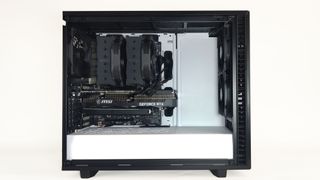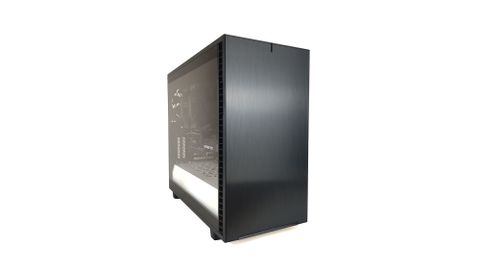IT Pro Verdict
Pros
- +
Powerful processing for single or multi-threaded tasks
Cons
- -
Conventional HDD is quite slow
We’ve been waiting for Intel to fight back against AMD’s onslaught in the workstation market for some time. Now that the 12th Generation of Intel Core processors has arrived though, perhaps we’re starting to see the hint of a change in fortune. The new ‘Alder Lake’ platform enables up to 16 cores for the Core i9, 12 for the Core i7, and 10 for the Core i5, plus support for DDR5 memory and PCI Express 5.0.
The first 12th-gen system we’ve had on the bench, Wired2Fire’s Apollo WS Video Editing Workstation comes equipped with the range-topping Intel Core i9-12900K and 64GB of DDR5 memory. But is this enough to challenge workstations based on AMD’s mighty Ryzen 9 processors?
Wired2Fire Apollo WS Video Editing Workstation review: Processor and memory
Like the Ryzen 9 5950X, the Intel Core i9-12900K, has 16 cores, but the configuration is rather different. Instead of a set of identical cores, each capable of running two threads, Alder Lake processors can have two types – “P” cores which are geared for performance and “E” cores designed to be more efficient. The P cores can run faster than the E ones, and can process two threads, whereas the E ones are single thread only.
How AMD fought its way back to relevance Nvidia GeForce RTX 3090 review: Caught between two worlds AMD unveils Ryzen 6000 laptop processors with RDNA2 graphics
In the case of the Wired2Fire’s Core i9-12900K, there are eight P cores running at a base 3.2GHz with a 5.1GHz boost, and eight E cores running at a base 2.4GHz with a 3.9GHz boost. Intel Turbo Max 3.0 enables a couple of P cores to run at 5.2GHz, for the best possible single-threaded performance.
Support for DDR5 is new with the 12th Generation Intel processors, and Wired2Fire has taken full advantage by providing 64GB of the new memory type running at a native 2,400MHz, but data-doubled to 4,800MHz. This provides 50% more bandwidth than DDR4-3200 memory, which is the typical format for current AMD Ryzen 5000 Series processors, and if that’s not enough, dual-channel memory is also supported for even greater throughput. The 64GB allocation is a plentiful baseline, but the two 32GB DIMMs supplied by Wired2Fire leaves two slots free for future upgrade should you need it.

Wired2Fire Apollo WS Video Editing Workstation review: Graphics acceleration
Wired2Fire has aimed the Apollo WS Video Editing Workstation at a specific task (the clue is in the name), so has eschewed professional-grade graphics acceleration, which isn’t so necessary if you’re not doing heavy professional 3D work. The GPU is still very potent, however, taking the form of an MSI GeForce RTX 3070 Ti Ventus 3X.
This is a PCI Express Gen 4 graphics card – something now supported by the latest Intel 12th Generation processors – and sports a whopping 6,144 CUDA cores running at a clock speed up to 1,770MHz. The 3070 Ti also sports 8GB of GDDR6X frame buffer on a 256-bit bus, offering a considerable 608GB/sec of bandwidth. There are three DisplayPort 1.4a connections plus a single HDMI 2.1 port. While the latter supports up to 4K at 120Hz, the DisplayPorts can drive up to 8K screens. Power consumption is quite high, though, clocking in at 290W.
Wired2Fire Apollo WS Video Editing Workstation review: Storage
The Apollo’s approach to storage is more traditional, consisting of a fast SSD for the operating system and applications, with a conventional hard disk included for media files. The former is a 2TB Samsung 980 NVMe SSD running at PCI Express 4.0 speeds. Using CrystalDiskMark 8, this drive delivers 6,631.64MB/sec sustained reading alongside 5,019.24MB/sec sustained writing.
Media storage comes in the form of a 4TB Seagate BarraCuda conventional 7,200rpm SATA hard disk. This provides much more pedestrian throughput compared to the NVMe SDD, delivering 197MB/sec sustained reading and 187MB/sec reading. While it’s no surprise that performance lags behind NVMe speeds, both of these are quite low even for current generation HDDs. The chassis comes with six additional bays for fitting either 3.5in or 2.5in drives, and this can be increased to 14 with optional extra caddies, so if you want lots of storage for video, this is entirely possible. There’s a single 5.25in optical drive mount too.
Wired2Fire Apollo WS Video Editing Workstation review: Chassis design
Speaking of the storage capabilities, these are provided by the excellent Fractal Design Define 7 chassis – a large and spacious case with a side window that is a top choice amongst workstation manufacturers currently. There are four Type A USB ports – two 3.0 and two 2.0 – on the top front edge, alongside USB Type C and separate minijacks for headphones and microphone. Wired2Fire has also opted for Noctua NH-D15 Dual Tower air cooling for the processor, rather than a water system, but with two meaty 140mm fans on a large heat sink, the Noctua still enables an incredibly quiet system.

The ASUS ProArt Z690-CREATOR motherboard also provides plenty of connectivity at the rear. There are 10Gbit and 2.5Gbit Ethernet LAN ports, six USB 3.2 Gen 2 Type A ports, two Thunderbolt 4 USB Type-C ports, plus five analog audio minijacks. There are antenna attachments for the onboard WiFi 6E, making this system fully ready for use in a studio with no wired LAN.
Wired2Fire Apollo WS Video Editing Workstation review: Processor performance
AMD has become dominant in the workstation market over the last couple of years, thanks to the sheer performance its processors provide for the money, but the Core i9-12900K shows that Intel has life in it yet. Running our in-house benchmark tests, the Apollo’s overall score is a colossal 658 – ahead of the AMD Ryzen 9 5950X of Armari’s Magnetar V16R-RD850G3, which could only achieve 617. With 260 in image editing and 638 in video editing, this machine has performance in the key creative areas at which it is aimed, and the multitasking score of 803 will give peace of mind to anyone looking to run multiple demanding applications at once.
These scores are also well out in front of previous generations of Intel Core i9 processors. However, in pure multi-threaded rendering the Intel processor is still a little behind AMD. Running Maxon Cinebench R20, the Wired2Fire scored 10,428, whereas the Armari’s AMD Ryzen 9 5950X managed 10,972. However, a real-world frame render with the Blender Gooseberry 3D benchmark takes 485 seconds, nearly a minute quicker than the Armari’s 541 seconds.
Wired2Fire Apollo WS Video Editing Workstation review: Graphics performance
Consumer-grade graphics such as the GeForce RTX 3070 Ti aren’t recommended for professional 3D applications, but although this system isn’t aimed at 3D work, the SPECviewperf 2020 benchmarks demonstrate that it depends on what software you’re planning to run. The results of 146.69 in 3dsmax-07 and 461.53 in maya-06, for example, show that this system will be more than adequate for animation with Autodesk 3ds Max or Maya.
The results of 82.16 in catia-06, 118.69 in creo-03, and 315.05 in solidworks-05 also reveal that some product design, engineering and CAD applications will run well (Dassault Systemes CATIA, Creo and SolidWorks respectively). As always, Siemens NX is the achilles heel, with just 26.37 in snx-04, which is only barely usable, but if you do want to approach 3D animation or CAD with professional acceleration, Wired2Fire can offer this system with NVIDIA Quadro graphics instead.

However, the 3070 Ti’s OpenCL grunt is good, with a powerful 12,521 in LuxMark 3.1, while rendering the Blender Gooseberry benchmark on GPU took just 180 seconds. In other words, anything needing OpenCL or CUDA will be well catered for.
Wired2Fire Apollo WS Video Editing Workstation: Verdict
With the Apollo WS Video Editing Workstation, Wired2Fire has put together a very competent professional system. Although you might want to switch to a Quadro for professional 3D work, for the intended video editing activities, it’s a powerful and well specified system for a reasonable price.
More importantly, it also showcases how much Intel has progressed with the latest 12th Generation CPUs. The Core i9-12900K can match and even exceed what AMD has to offer with its comparable flagship, the Ryzen 9 5950X. After a few years of playing second fiddle, it looks like Intel’s finally back in the fight.
Wired2Fire Apollo WS Video Editing Workstation specifications
| Processor: | 3.2GHz Intel Core i9-12900K |
| RAM: | 64GB 4,800MHz DDR5 |
| Graphics: | 8GB GDDR6X MSI GeForce RTX 3070 Ti Ventus 3X |
| Storage: | 2TB Samsung 980 PRO M.2 NVMe SSD; 4TB Seagate BarraCuda 7,200rpm SATA HDD |
| Operating System: | Windows 11 Professional 64-bit |
| Warranty: | 5 years (2 years collect and return, 5 years labour) |
Dr James Morris has worked as a technology journalist for over 25 years, including spending nine years on the staff of market-leading computer magazine PC Pro, the last five of which were as the publication’s editor. He specialises in enterprise-grade software and hardware, with a particular focus on content creation. He launched a pioneering video channel for HEXUS.net in 2006 and ran the video reviews channel for TrustedReviews.com for four years. He also runs a successful online digital content and commercial video production company, t-zero communications Ltd.
Dr Morris is a prolific technology writer and contributes commercial content for major IT brands including AMD, BlackBerry, Dell, Cognizant, HP, and IBM. He published a book on artificial intelligence, Can Computers Create Art? in 2009. He is also an academic, and is currently Pathway Director of the MA, Interactive Journalism at City, University of London.
Previously, he was course leader for the BA in Web Media Production at Ravensbourne University. He has a PhD in Philosophy, Art and Social Thought from the European Graduate School in Switzerland, a Master's in Media Arts from the New School in New York, USA, and a Bachelor's in Social Anthropology from the London School of Economics.
Dr. Morris can be found on Twitter at @Cyberwest, or emailed at j@tzero.co.uk



